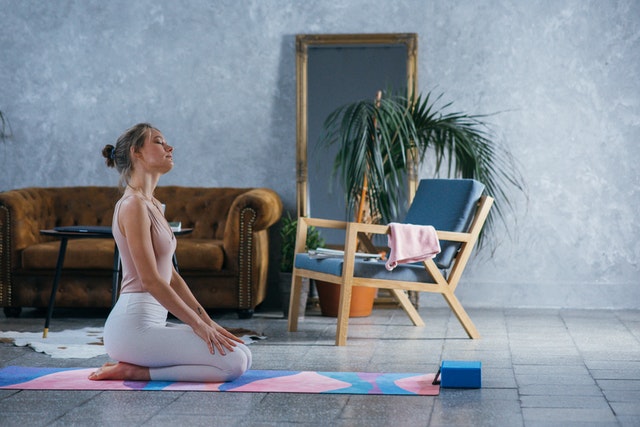Thinking about trying meditation for anxiety? A few sessions will help with some of your troubling thoughts like:
“What if my partner doesn’t love me and just feels sorry for me?”
“My boss probably hated my presentation, no wonder I won’t get the next promotion.”
“I could try that, but what if it doesn’t work?”
Sound familiar? You may be one of 40 million Americans that struggle with anxiety daily. But what do all these everyday worries have in common? They don’t have any proof – and feed on your insecurities. Maybe you’ve considered meditation for anxiety, but what happens when you google that? Try searching “Youtube meditation for anxiety” and let me know which of the 1,000 videos you choose. It’s tough, right?
A few years ago, anxiety ruled my mind. I couldn’t bring myself to make big moves or plan for the future because of so many different “reasons” that were really just fears.
I thought: What if I don’t make it? What if I lose my job and have no income? What if everything falls apart?
Once I learned how to meditate, everything changed. I didn’t let anxiety hold me back anymore. Instead, I became more aware of my thoughts, goals, and desires. That’s the center of my Stillness to Success course. I help people figure out what success means to them and tackle obstacles like anxiety with meditation.
So, how do you maintain a successful meditation practice for anxiety?
Take a deep breath and imagine your worries drifting away with your exhale. Just for a few moments, let it all go. For now, anxiety takes the back seat. Today, you’ll learn how to use meditation for anxiety to carve out space in your mind for what’s most important.
Before we get into the tips you’ll need to get started, you might wonder: does meditation for anxiety work?
Is Meditation for Anxiety Effective?
Our thoughts are mighty, especially the anxious ones. The amount of space they take up in your mind might make you doubt whether meditation helps. But your doubts end here. Countless scientific studies demonstrate meditation’s positive effects on anxiety.
Psychiatry researchers explored how meditation affected a sample group of people with generalized anxiety disorder, the first randomized, controlled trial (RCT) of its kind. Researchers measured participants’ placements on various anxiety scales, noting significant drops after participation in a meditation session.
But is it possible to have anxiety symptoms without a diagnosis like the participants of the above study? Absolutely.
It’s natural to feel anxious during stressful periods.
Other researchers recognized that caveat when they studied over 200 articles and 36 RCTs to specifically explore meditation impacts on anxiety symptoms. The result? Meditative therapies effectively reduce some anxiety symptoms, like rapid heart rate, nervousness, and exhaustion.
To sum it up, how does meditation help anxiety? Meditation:
- Reduces stress
- Calms the mind
- Increases awareness
- Helps people focus on the present
Meditation for anxiety relief isn’t just a theory. It’s a proven tool. We know it helps, but you’re probably wondering: How do I start meditating for anxiety?
Meditation for Anxiety: 5 Tips and Tricks
Ready to harness the power of meditation to relieve stress and anxiety? Check out these easy tips to shut down those pesky paranoias when they start flaring up.
Tip #1: Start With a Guided Meditation for Anxiety
Are you new to meditation? If so, sitting still for more than 5 minutes might feel jarring. But five minutes is all you need to calm your anxiety.
But what meditation is good for anxiety specifically? If you don’t know where to start, try a guided meditation!
Youtube “meditation for anxiety” and scroll through the options. What draws you in? Find a 5-minute or 10-minute meditation to get started. The Youtuber will guide you through some deep breathing and narrate your thoughts to help you stay on task. I especially like this 5-minute meditation for anxiety video by Anita Benitez.
After you try a few guided meditations, it’s easier to meditate independently. You’ll learn mantras, breathing exercises, and stretches that you can tailor to your own practice.
Tip #2: Mind Your Surroundings
Look around your space. Are there endless loose papers spilling out of your desk? Clothes piling up on the chair? Clutter makes us anxious, so it’s not ideal for a meditation session.
Take a few extra minutes to start your meditation on the right foot. Clean up your space to put yourself in a calmer mental state before your meditation session.
All cleaned up? Perfect. Let’s drown out those anxious thoughts with something more uplifting…
Tip #3: Find a Mantra
I’ll always remind you to come back to your breath during meditation. But what if your thoughts are too loud to get there? Sometimes I like to repeat a mantra, using new words and phrases to replace my anxious thoughts.
Here are some helpful mantras for anxiety:
“This too shall pass.”
“I’ll cross that bridge when I get there.”
“I am safe and secure.”
“This is temporary.”
“I am worthy of a calm life.”
“My thoughts don’t control me.”
“I deserve compassion.”
Feel free to think of your own unique mantras as well! If you’re still having trouble drowning out your thoughts, don’t worry. This next step will help with that.
Tip #4: Acknowledge Your Anxieties
Maybe a mantra isn’t enough to settle your relentless, anxious thoughts. And that’s OK – at the end of the day, we’re not trying to eliminate them. We’re just trying to function without being controlled by them.
It’s easy to get discouraged during meditation when troubling anxieties start playing out in your mind. You won’t succeed in ignoring them, but you can let them go. Acknowledge each anxiety, one by one. Label them. Sit with them.
Experts say that acknowledging your emotions is the first step to addressing and managing them.
Now, how do you maintain the momentum?
Tip #5: Make Meditation Your Routine
A UK study about habits found that the average adult needs 66 days to implement a habit into their routine. What does that mean for meditating with anxiety? You have to accept that your practice won’t happen overnight.
The best meditation for anxiety and depression is consistent, daily practice. Are you starting small with deep belly breaths? Do them every single day. Moving onto a more robust mindfulness meditation for anxiety? Don’t give up after one or two sessions.
Incorporate meditation for anxiety into your daily routines. I like to pair my meditations with another daily routine, like reading before bed or brushing my teeth. This helps me make time for it, even on busy days.
Soothe Your Anxiety with Stillness
Meditation for anxiety is proven to alleviate symptoms and settle a restless mind.
Anyone can meditate, no matter how anxious their thoughts are. The best part? With endless support from guided meditations and mantras and a little self-discipline through routine, I promise – you can learn how to meditate and soothe your anxiety.
Ready to learn more about meditation, mindfulness, and ways to achieve success? Sign up for my monthly newsletter for more stories, courses, and articles like this one.
Anxiety is manageable. Quiet your thoughts and open your heart to tranquility, peace, and success. You can do this.
“Reality is created by the mind. We can change our reality by changing our mind.” – Plato







Leave A Comment